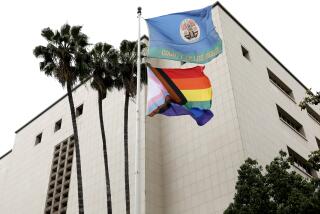Neighborhood Councils Aren’t Made in a Day
- Share via
The creation of a neighborhood council system, as mandated by the new City Charter, is an essential step in building a Los Angeles that belongs to all its people and brings them together in search of the common good.
Since March, the city’s Department of Neighborhood Empowerment, or DONE, has been conducting regional planning workshops in order to gain neighborhood stakeholders’ input about the appropriate size, boundaries and structure of neighborhood councils. Now the department must formulate a coherent plan that ensures that every part of the city is within the boundary of a neighborhood council and establishes the criteria that councils must meet in order to be certified by the city.
Flexibility will be one of most important determinants of a successful neighborhood council plan. The preferences voiced at the USC Neighborhood Participation Project’s April conference of 150 neighborhood leaders from across the city echo findings from published research that argue in favor of maximum discretion to neighborhoods in determining the size, boundaries and organizational structure of their councils. Given the tremendous geographic and cultural diversity of Los Angeles, and the great disparities in levels of organization in different parts of the city, neighborhood councils must be built from the bottom up.
Instead of establishing detailed criteria for the creation of the councils, the plan should include a clear process that permits negotiations to clarify neighborhood boundaries, reaches out to stakeholders, reconciles overlapping boundaries and promotes inclusion of economically disadvantaged neighborhoods. Experience with successful neighborhood councils in other cities suggests that this will be an extended process. In the city of St. Paul, for example, the process of negotiating boundaries took two years.
The neighborhood council plan also must outline a flexible implementation process that allows for change over time. At this early stage, no one knows how a council system will best be implemented. The plan should allow for a continuous process of review, ensuring that the plan will be amended to reflect new knowledge, experience and changing circumstances.
Even the best plan will not be successful without substantial commitment from the city. We urge the mayor and City Council to recognize the broad needs of neighborhoods for training and technical assistance and to provide adequate resources to the Department of Neighborhood Empowerment to support stakeholders’ efforts at organizing, outreach, mediation, communication and networking across neighborhoods. In particular, the mayor and City Council should fund the citywide Congress of Neighborhoods required under the City Charter. These resources must be made available even while the neighborhood council plan is being developed.
Ultimately, of course, the success of neighborhood councils will rely on stakeholders embracing the planning and implementation process. The current planning timeline offers a number of critical junctures at which stakeholders can influence the policy-making process: Neighborhoods must act now by submitting written ideas for the neighborhood council plan for DONE to review while writing the plan this summer; speaking out at public hearings on DONE’s proposed plan in the fall; and lobbying the City Council after it receives the final proposal from DONE in December 2000.
Effective neighborhood councils will not evolve overnight. They will require the continued commitment of residents, the business community and city officials. Neighborhood stakeholders and the city must view the current planning process as an investment in the long-term participatory infrastructure of Los Angeles and cultivate an attitude of patience and tempered optimism. As always, democracy is a work in progress.
More to Read
Sign up for Essential California
The most important California stories and recommendations in your inbox every morning.
You may occasionally receive promotional content from the Los Angeles Times.













